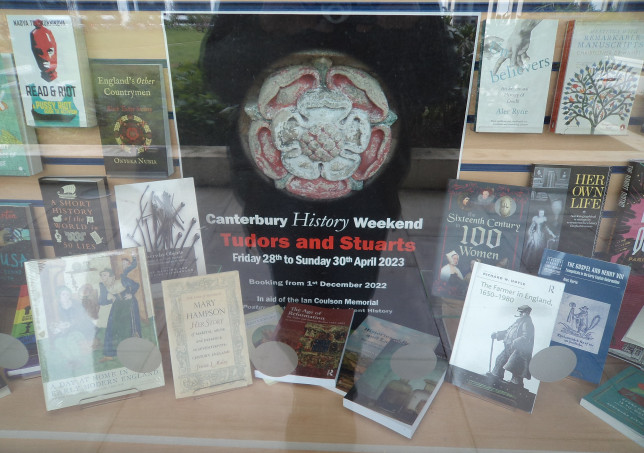In addition to Tudors & Stuarts 2023 which is coming up THIS weekend – see #TS2023 – thanks very much Craig for a great window display in the CCCU Bookshop, and tickets still available including during the Weekend, just come along to the temporary Box Office in Old Sessions House (cash and cards accepted), there have been other events this week.
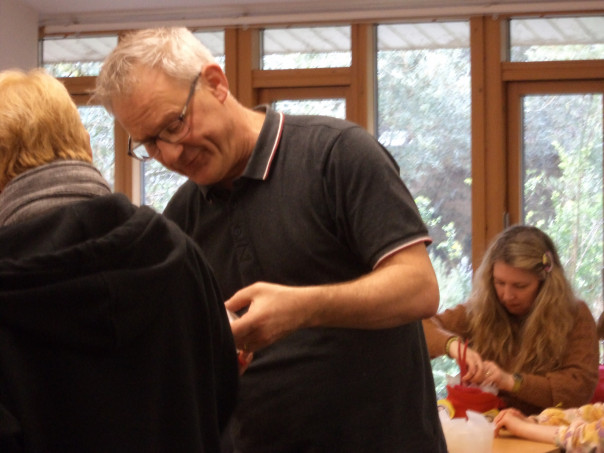
Now I’m not talking about the VIP visit but rather Dr Diane Heath’s NHLF-funded ‘Medieval Animals Heritage’ St George and the dragon(s) afternoon, as well as the Kent Maps’ Reimagining Kent’ symposium that I dropped into for a couple of sessions. Apologies to those I didn’t hear and I’m just going to report on a couple of the presentations that I did hear for the sake of brevity – apologies to those not here and there is the twitter feed #kentmaps to get a flavour of the day.
Returning to St George, Diane, Dr Pip Gregory, Martin Crowther, Laine and a considerable number of volunteers – CCCU staff and students gathered in Laud seminar rooms to greet the SEND families as they arrived for the afternoon’s activities. Due to the weather, it was decided to leave the dragon egg hunt to last and to hold the St George play in the more open area in Laud rather than in Becket Garden with the ‘Green Dragons’ – a sensible plan! Consequently, Martin started the children, parents and carers on designing and making a ‘dragon’ baseball cap which they can wear if they want to in the parade as part of Canterbury’s ‘Medieval Pageant’ on Saturday 1 July. The theme this year being ‘Medieval Animals’. Martin had provided lots of useful materials to make the dragon’s eyes, ears, teeth, tongue and tail, and the volunteers helped where required as these creations took shape. Indeed, there were some very scary dragons ‘coming to life’ that afternoon!
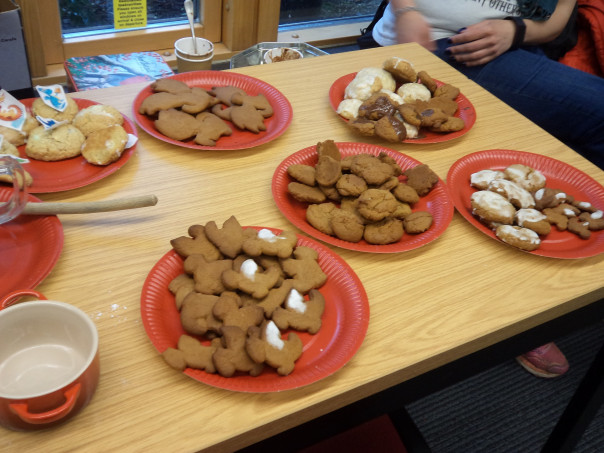
Now designing and creating is thirsty work and once we were sure everyone was happy with their ‘dragon’ cap, we moved into the next room for refreshments, including Pip’s fantastic dragon-shaped ginger biscuits. She has a Victorian recipe and those attending, as well as some of the volunteers, can vouch for their quality! While people were eating and drinking, Martin provided a story about a dragon who terrorised the country but was scared of mice. Thus, when a mouse moved into the cave next door it was role-reversal and the mouse came out on top, thereby getting the cheese. Next, we had another dragon story read by Vicki Adams, an American student who has been helping build the baby ‘Green Dragon’ this term. This is her favourite dragon story and Daniel, one of the other volunteers, helped her by being the dragon and roaring when required by the storyline.
After all this excitement and suitably refreshed, the student volunteers and Laine who were involved in the play got into their costumes and we all trooped into the open area in Laud to watch the St George mumming play that Dr Sonia Overall had kindly adapted from one used by the Canterbury Mummers. Just as an aside, having taught a module at the University of Kent called ‘Early Drama’, it was good to see the Lutterworth St George play getting another makeover. Sonia had also very kindly lent Diane a couple of ‘horses’ and some costumes, while St George was resplendent in a surcoat, as hopefully you can see. St George, of course, had a squire whose primary function was to hold the ‘horse’ during the duel between him and ‘Bold/Captain Slasher’, who also had a horse and squire for the same duty. As in all such good fights the hero – St George, was victorious with Bold/Captain Slasher dying beautifully – well-done Laine. Indeed, St George was played by Eleanor so definitely embracing equal opportunities. The youngsters had enjoyed the play so much that there were several reruns, especially the fight, although they all ended in draws because nobody else fancied ‘dying’.
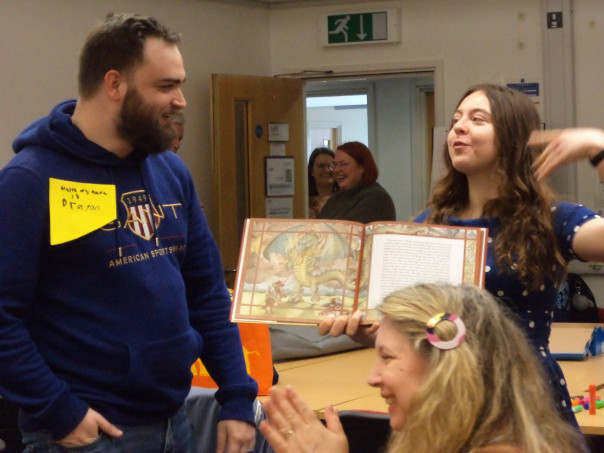
The final part of the activities was the dragon egg hunt and because it had almost stopped raining, everyone was happy to go out to Becket Garden to visit the ‘Green Dragons’ and hunt for the dragon eggs. This also provided a chance to clear everything up and by the time the egg-hunters returned it was all tidy and Diane could have a final word with the families to find out whether they had enjoyed themselves – they had, and to remind them that for those interested, they would be most welcome to show off their ‘dragon’ caps and t-shirts at the ‘Medieval Pageant’ during the parade. In addition, Diane, Pip and Martin now have a host of potential names for the baby dragon, provided by the youngsters, so watch this space for the result in due course.
I now want to turn to ‘Reimagining Kent’, and I just want to mention a few of those I won’t be reporting on because there is Martin Crowther’s presentation on the Maison Dieu and Dover: https://blogs.canterbury.ac.uk/kenthistory/highlighting-dovers-maison-dieu/ Sonia Overall’s presentation on Hooden Horses: https://blogs.canterbury.ac.uk/kenthistory/historical-research-the-exciting-county-of-kent/
Dr Maria Diemling’s presentation on the Holocaust, ‘Postmemory’ and the Torah scroll at Ramsgate: https://blogs.canterbury.ac.uk/kenthistory/kent-history-and-heritage-engaging-communities/ and Dr Jane Lovell’s presentation on ‘Dreamlands and Secret Histories’. I’m sure these were all excellent – see twitter and equally all the others too.
However, I was able to catch a small number of these interesting and varied presentations and to try to give a flavour of this variety, I want to mention two with a very brief postscript on what I was talking about. To begin, I’m taking you to late Stuart New Romney and Dr Pat Argar’s presentation on the enterprising John Mascall of New Romney. As she said this hunt for his biography began with her and a friend’s project to record the inscriptions on gravestones and then grave slabs in and around St Nicholas’ church in the town. They are interested in telling these people’s stories and John Mascall’s is definitely worth telling because as well as being extremely colourful, it provides some fascinating insights into the inter-actions and inter-dependency between local and national, as well as relationships within the provinces, between the provinces and London, and town and crown among other matters.
Mascall died in 1705 having been a leading civic officer in this Cinque Port Head Port, and his prominence locally also meant that he held office in London, as well as marrying well which meant that his wealth and status placed him among the area’s gentry families. Among his many assets was a considerable acreage of land on Romney Marsh, and his large house on the High Street equally proclaimed his position, as did his very large family pew that he had built which was known as the ‘Great Seat’.
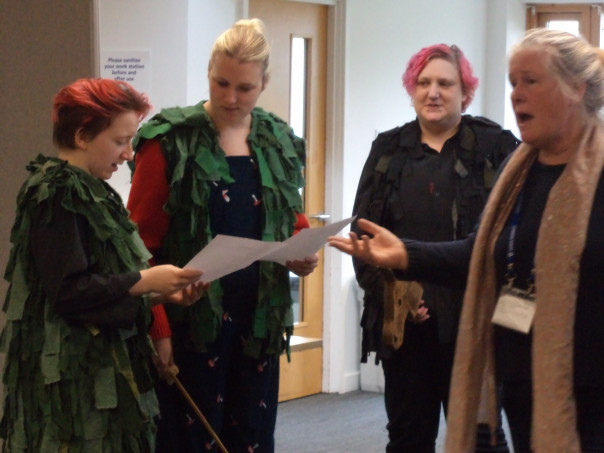
In the last years of his life, he moved into the privateering business taking advantage of the crown’s need to suppress shipping to French Channel ports as a way of conducting hostilities as part of the War of the Spanish Succession. Also seen as retaliatory tactics to stop French ships from taking Cinque Ports and other shipping that was anchored off Dungeness and elsewhere, Mascall’s seven vessels with their 78 big guns and over 700 seamen waged a lucrative ‘war’ that between 1703 and 1705 netted Mascall £20,000. During that time, his men captured 44 prizes which included ships from several countries, especially Sweden and Denmark but only eight French ships. Interestingly, rather than his men having a share of the prize money, he paid them a monthly wage. Not that this was his only venture into privateering, but it was his most successful and I’ll leave his long-distance venture that brings in Alexander Selkirk (‘Robinson Crusoe’) to another time, or better still, check out Kent Maps in a few months’ time because by then Professor Carolyn Oulton will have persuaded or Pat will have volunteered to write a piece on him for the project.
To the second presentation I want to feature, Jane Joyce gave us a reflection on her journey to discover how to counter her fear of being inadequate, what she called the ‘imposter syndrome’, as a way of encouraging everyone ‘to have a go’, just as she has done. She began by giving us a clear road map so that we could chart her progress as she gained more experience, archival skills and hopefully confidence from her earliest forays into volunteering, as part of an archival research team in the CCCU library, to her latest projects at the Chatham Dockyard on the experiences of disabled sailors and others linked to the dockyard as seen in the archives.
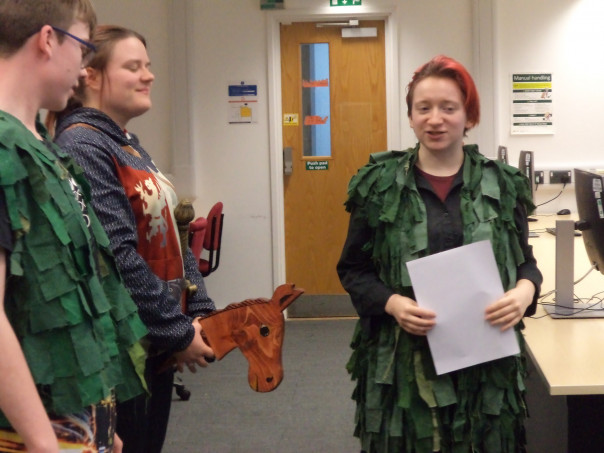
Along the way, she has been part of a project team at the University of Kent in its Special Collections under the title ‘Fish and Chips’ that involved researching the impact of the potato famine of the 1960s and how it was portrayed in the cartoon collection there for an exhibition. Each time Jane has taken on bigger and bigger challenges, and her next project was at the Royal Engineers at Gillingham where she was entrusted with taking the archival process all the way through from scanning photos in their collection to cataloguing and adding everything to the database so that it is available to researchers wanting to explore the museum’s collections. Her work at Chatham Dockyard has also included doing some filming, which means that she now has an enviable skill set and is well placed to take on new challenges, whether it is even more at the Dockyard or with the Royal Engineers, or maybe elsewhere. So a couple of very different but thoroughly fascinating presentations where reimagining people was at the heart of what Pat and Jane had been able to achieve.
So very briefly what did I bring to the today? Like Martin Crowther, I was reimaging Dover, or more accurately demonstrating ways to give people the tools so that they can do it themselves. This involves what you might call a pilot project in knowledge exchange and impact which has two parts to it: a temporary exhibition on six aspects of living, working and dying in late medieval Dover, and three, free ‘Working with Wills’ workshops, also to be held in St Mary’s church. The latter will allow participants to explore primary sources – we’ll see who, where, when, and how wills were made, and then try out reading late medieval handwriting in a friendly, co-operative environment because some will take to it like the proverbial duck to water and others won’t. The second part of the workshop will be devoted to examining what the different bequests can tell us about the will-maker and the community he (very few wills made by women, mainly widows) lived in. Thus, we’ll be able to link up to at least some of the exhibition themes if I chose my wills carefully, as well as being aware that, yes, wills are fascinating but like all forms of evidence, they can at times obscure far more than they reveal. To finish, all of this will take place in July and details of how you can apply to come on one of these workshops will be available shortly.
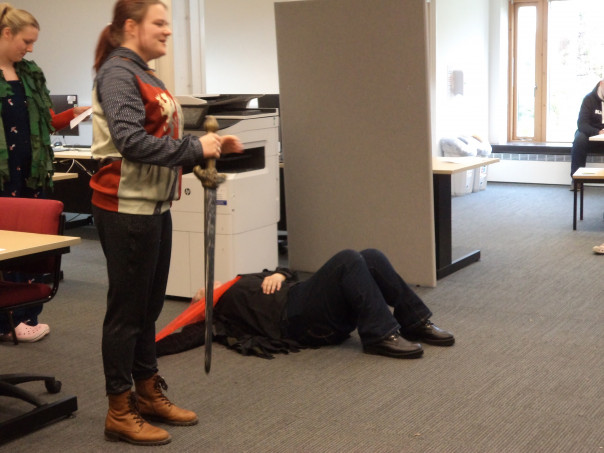
Even though I had only been to a few presentations, I could tell from the reactions of others that it had been a highly successful day. Consequently, Carolyn, Michell Crowther, and most particularly Hayley Smith should be congratulated on the day, and in the time-honoured way at least some of those involved retired to The Two Sawyers afterwards.
 Centre for Kent History and Heritage
Centre for Kent History and Heritage Sheila Sweetinburgh
Sheila Sweetinburgh 1322
1322